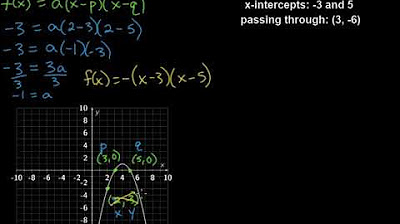Menyusun Rumus Fungsi Rasional #fazanugas
Summary
TLDRIn this tutorial, the presenter explains how to derive the rational function formula from a given graph. Focusing on horizontal and vertical asymptotes, the video guides viewers step by step in identifying key components of the graph. By analyzing the asymptotes, intersections, and using algebraic manipulation, viewers learn to determine the formula for functions such as y = (Ax + B) / (Cx + D). The session also touches on using specific points on the graph and applying assumptions to simplify the process. Overall, it's a comprehensive guide to converting graphical data into a functional formula.
Takeaways
- 😀 The lesson is about determining the rational function formula from a given graph.
- 😀 The general form of the function being discussed is y = (AX + B) / (CX + D).
- 😀 The video explains how to analyze horizontal and vertical asymptotes from the graph.
- 😀 Horizontal asymptotes follow the formula y = A / C, and in this case, y = 2.
- 😀 Vertical asymptotes are determined by solving for x = -D / C; in this case, x = 0.
- 😀 To find the function, you use the known points and asymptotes on the graph.
- 😀 The point (-3, 0) is an x-intercept that helps derive the function by substituting into the equation.
- 😀 By substituting (-3, 0) into the function, you get the equation -3A + B = 0, which simplifies to B = 3.
- 😀 A logical substitution approach is used to solve for unknown variables, such as assuming C = 1.
- 😀 The final function equation derived from the analysis is y = (2x + 6) / (x).
- 😀 The video encourages using points where the graph intersects the axes to simplify solving the function equation.
Q & A
What is the main focus of the video?
-The video focuses on determining the rational function formula from a graph, specifically for the function y = (Ax + B) / (Cx + D).
What is the first step in analyzing a graph to find its rational function formula?
-The first step is to identify the horizontal asymptote, which is a key feature in finding the rational function formula.
How is the horizontal asymptote determined from the graph?
-The horizontal asymptote is identified as the value of y that the graph approaches as x tends to infinity or negative infinity. In this case, the horizontal asymptote is y = 2.
What is the formula for the horizontal asymptote?
-The formula for the horizontal asymptote is y = A/C, where A is the coefficient of x in the numerator, and C is the coefficient of x in the denominator.
How is the vertical asymptote identified in the graph?
-The vertical asymptote is identified by the value of x where the graph approaches but never crosses. In the example, the vertical asymptote is x = 0.
What is the formula for the vertical asymptote?
-The formula for the vertical asymptote is x = -D/C, where D is the constant term in the denominator and C is the coefficient of x in the denominator.
How do we determine the values of A, B, C, and D from the graph?
-To determine the values of A, B, C, and D, we use known points on the graph, such as intercepts or points where the graph crosses the axes, and substitute them into the rational function formula.
What role does the point (−3, 0) play in finding the function formula?
-The point (−3, 0) represents a root of the rational function, and substituting this point into the equation helps find the relationship between the constants A and B.
How is the value of B calculated from the given point (−3, 0)?
-From the point (−3, 0), we substitute x = -3 and y = 0 into the function formula and solve for B, leading to the equation −3A + B = 0, which gives B = 3A.
What happens if you choose C = 1 when solving for A, B, and D?
-Choosing C = 1 simplifies the process and avoids unnecessary complications. With C = 1, we can easily solve for A, B, and D using the equations derived from the graph.
Can the values of A, B, C, and D be found without using intercept points like (−3, 0)?
-While intercept points are helpful, it is not strictly necessary to use them. Alternative points, such as those on the axes, can also be used. However, using intercepts tends to be more efficient in finding the function.
What is the final rational function derived from the graph in the video?
-The final rational function derived from the graph is y = (2x + 6) / x, where A = 2, B = 6, C = 1, and D = 0.
Outlines

このセクションは有料ユーザー限定です。 アクセスするには、アップグレードをお願いします。
今すぐアップグレードMindmap

このセクションは有料ユーザー限定です。 アクセスするには、アップグレードをお願いします。
今すぐアップグレードKeywords

このセクションは有料ユーザー限定です。 アクセスするには、アップグレードをお願いします。
今すぐアップグレードHighlights

このセクションは有料ユーザー限定です。 アクセスするには、アップグレードをお願いします。
今すぐアップグレードTranscripts

このセクションは有料ユーザー限定です。 アクセスするには、アップグレードをお願いします。
今すぐアップグレード関連動画をさらに表示

Menyusun Rumus Fungsi Kuadrat #fazanugas

Point Slope Form - Basic Introduction - Algebra

Relasi dan Fungsi Matematika Kelas 10 • Part 24: Fungsi Rasional Bentuk 2 - Linear / Kuadrat

Menggambar Grafik Fungsi Rasional #fazanugas

Writing Quadratic Functions in Intercept Form

EQUAÇÃO DA FUNÇÃO AFIM - EXERCÍCIO - Professora Angela Matemática
5.0 / 5 (0 votes)
